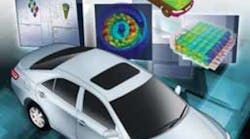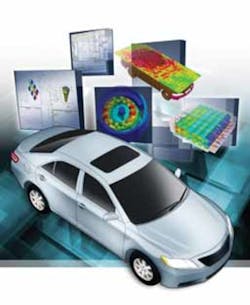Simulation addresses the four pillars of automotive electrification
The two great changes in automotive industry include the ongoing electrification transformation and the drive toward autonomous systems, according to Lawrence I. Williams, Ph.D., director of technology at ANSYS. “ANSYS has a long history of contribution for each for the four ‘pillars’ of electrification: battery, power electronics, electric motors, and electric powertrain integration,” he said. Batteries need to be designed at the electrochemical level, and integrated battery pack thermal-mechanical considerations must be accounted for to ensure reliability and to prevent thermal runaway. Power from the battery must be managed by power-control circuitry and then be distributed via busbars and cables. Electric machine design centers around efficiency and quiet operation across a range of speed and loading conditions. Finally, full system integration of the electric powertrain must be achieved with system-level analysis with the embedded controller software and the vehicle. “The ANSYS platform enables design teams to deliver on all pillars,” he said.
Williams described specific ANSYS products for automotive applications in an article in the October issue of EE-Evaluation Engineering (p. 6), and in the same issue, his colleague Sandeep Sovani, Ph.D., Global Director, Automotive Industry, commented on simulation’s role in advanced vehicle technology and outlines ANSYS’s role in Volkswagen’s record-breaking run June 24 at The Pikes Peak International Hill Climb (p. 20). Here, Williams elaborates on the challenges engineers are facing with the trends toward electrification and autonomous operation.
(Courtesy of ANSYS)
Reliability
“Any electronic system that is critical to the operation and safety of a vehicle must be reliable,” Williams said. “The electronics must operate without impairment due to improper signaling or interrupted operations due to firmware restart or electromagnetic interference, and they must exhibit thermomechanical reliability.” He added that signal and power integrity can be simulated with modern electromagnetic simulation coupled with circuit simulation.
“All aspects of the electronic module can be examined to ensure reliable power delivery for both DC and rapid-signaling operation,” he said. “Signal-integrity design engineers know that most EMI challenges are related to insufficient signal- and power-integrity design.”
Of course, issues related to firmware, signal integrity, power integrity, and EMI represent only a part of the potential problems. “The automotive environment is harsh on electronic modules,” Williams said. “Heat, vibration, and shock all threaten to cause system failure. Temperature cycling, for instance, repeatedly expands and contracts electronic-module circuit boards and components with the potential for delamination or solder-joint failure. Solving these challenges requires a full assembly modeling capability with integrated multiphysics simulation.”
Williams added that beyond electrical and physical design, modern electronic modules have embedded firmware and software, and the functional behavior of the overall system is only as good as the software that has been embedded. “Safety standards for reliable embedded code such as ISO 26262 and AUTOSAR are leveraged to ensure that overall system safety is met,” he said. “Moreover, new functional safety simulation tools should be leveraged to test operation of the embedded code. Finally, system-level integration with sensors and active controls is always the final step in development to ensure proper operation of electronics and software.”
Williams emphasized that electronics design cannot take place in isolation. “The challenges of signal integrity, power integrity, EMI, and thermo-mechanical reliability must be included to deliver systems that meet requirements for transportation,” he said.
He discussed as a simple example of the thermal design of electronic modules. “For most electronic systems, the main source of heat is electrical energy dissipated in semiconductor devices,” he said. “Additional sources are Joule heating of package and PCB traces that conduct significant current and the external sources of heat from the surroundings. There are, therefore, multiple internal thermal sources (Joule heating) and external sources (semiconductors and surroundings). All must be considered for reliable design. A single design platform for all effects greatly streamlines meeting these challenges.”
Autonomous vehicles
Williams then commented on self-driving cars and approaches to safety. “There is a virtual ‘Gold Rush’ to deliver autonomous driving with the likes of Waymo, Uber, Aptiv, BMW, and countless others competing to be first,” he said. “The autonomous vehicles have the potential to become safer than human driving, but not before an entire ecosystem is developed for design, test, and implementation.”
He cited the three core sensor modalities: camera, radar, and lidar. “The idea is that a fused set of sensors provides information of the dynamic driving environment, and the modalities complement one another using their individual virtues,” he said.
“Creating embedded code to drive the vehicle is like any other software development,” he continued. “Any software updates must be compiled and then regression-tested to ensure that changes in one area do not cause errors in another. That regression testing is done against a test suite of drive ‘scenarios’ that include highways, other vehicles, pedestrians, bicyclists, buildings, guard rails, etc.”
He explained that ANSYS has developed a comprehensive simulation environment that can provide a virtual representation of those scenarios based on real physics and behavioral modeling. “This solution is open and configurable to validate vehicle performance for safety requirements through simulated miles driven, flown, or maneuvered,” he said. “Its open nature integrates an ecosystem that includes, but is not limited to, high-fidelity physics, sensor models, vehicle dynamics, world scenarios, embedded software, connectivity and data analytics, and functional safety analysis. It can be configured to a given development environment, hardware-in-the-loop requirements, and vehicle architecture.”
Williams concluded, “Simulation is the practical answer to evaluating the performance of ADAS systems. According to a recent report from a reputed autonomous car developer, 5 million road miles were driven or tested in nine years. Contrast this with 2.5 billion miles driven in just one year, thanks to simulation and its capacity. Having said that, choosing an appropriate suite of simulation products is critical because designing ADAS systems must account for safety, reliability, accuracy, and efficiency. Herein lies the importance of ANSYS products. ANSYS offers a comprehensive suite of simulation products that can tackle multiphysics problems and provide accurate, reliable and efficient solutions. Moreover, the ability to handle large-scale problems is paramount for ADAS systems.”EE



